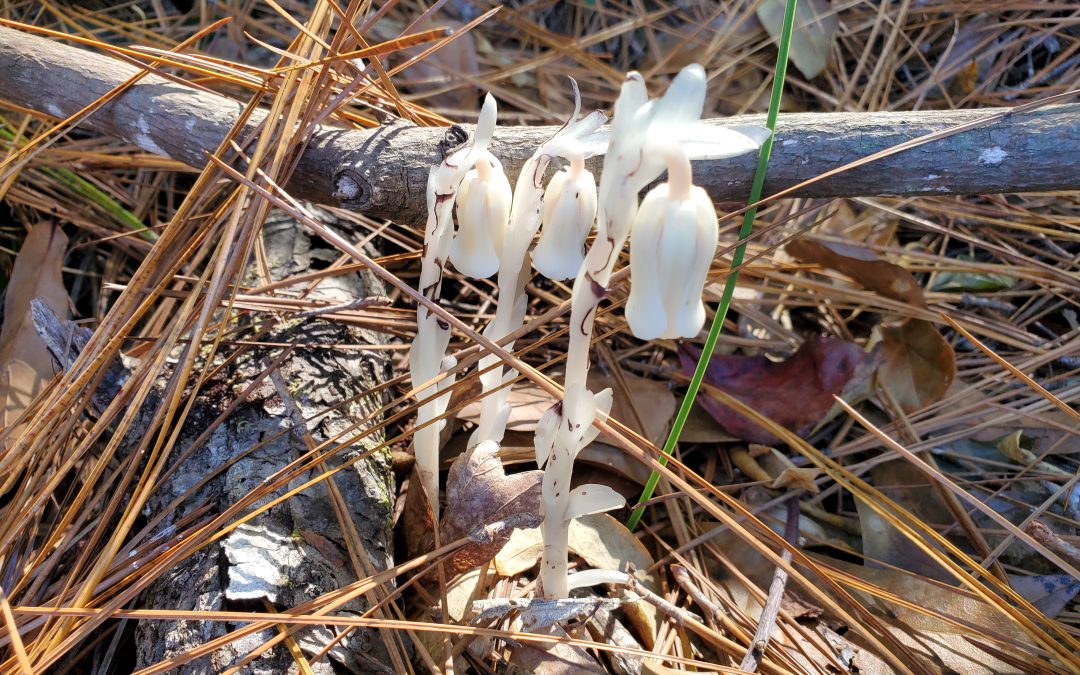
by Evan Anderson | Dec 2, 2021
There are many problems that can plague a plant in our environment, from fungi that love the humidity in North Florida to insects that chew through leaves. One less common but interesting source of stress for plants comes from…other plants?
Most plants are content to gather energy from sunlight and nutrients from the soil in which they sink their roots. Some species, however, have taken up thievery as a lifestyle. Parasitic plants are those that take the nutrients they need to grow from other plants. Some rely completely on their hosts for nutrients, others are able to produce at least some of their own, while yet more can live on their own but steal nutrients if another plant is conveniently nearby. Furthermore, there are some plants and similar organisms that may seem to be parasitic, but actually do no harm.
Mistletoe is a common sight especially in the winter when trees’ leaves have dropped. It relies on its host for water and nutrients, though it can produce energy from photosynthesis. Being evergreen has led it its adoption as a symbol Christmastime, and it has historically been important to other cultures such as the Celtic druids. Too much mistletoe can weaken a tree, and removing it can help to reinvigorate one that is struggling. Physical pruning is often the only method available for its removal, and this can be difficult on a tree of any size.
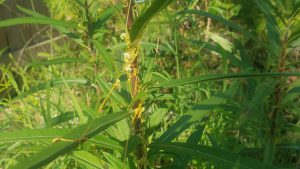
Yellow tendrils and white flowers of dodder.
Dodder has a strange appearance, looking like someone threw a batch of angel-hair pasta all over a plant. There are ten different species of dodder in Florida and they may be found on a variety of host plants. This parasite is leafless and takes all it needs from its host, and cannot survive independently; though it germinates from the ground, it has no true roots. Controlling an infestation of dodder involves removing affected plants or at least pruning off the branches that are hosting the parasite. Herbicides will kill it, but they will also kill the host.
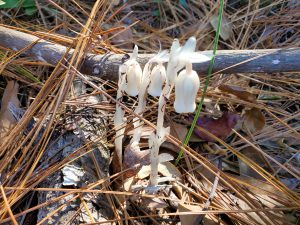
Ghost Pipe flowers
Ghost Pipe may be seen flowering from early summer through autumn, typically in woodland areas. It does not take its nutrients directly from a tree, but instead from mycorrhizal fungi. These helpful fungi attach to a tree and act like extra roots, assisting to absorb nutrients in return for energy from the plant. The ghost pipe helps itself to both nutrients and energy and does not bother to photosynthesize for itself, which gives it its stark white appearance.
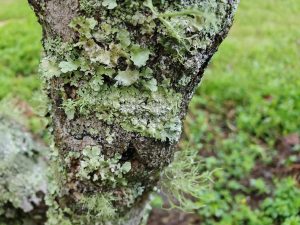
Lichen may grow profusely on trees, but does not harm the plant.
There are also plenty of harmless plants out there, such as Spanish moss and resurrection fern, which grow on trees but are not parasitic. Lichens, while not plants, are similarly prolific on the bark of trees, but do no harm.
For help in identifying a potential parasitic plant, contact your local Extension office.
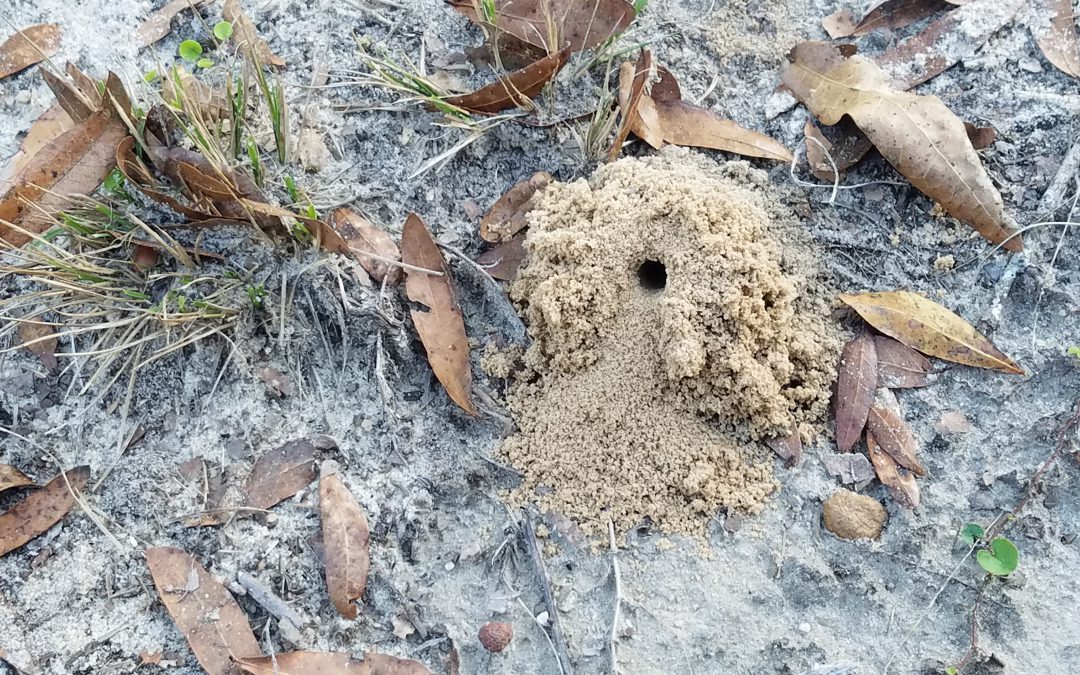
by Evan Anderson | Oct 21, 2021
While most people are familiar with the European honey bee, the domesticated insect that pollinates our crops and provides us with honey, there are plenty of other species of bees and their relatives out there. Most of them are harmless, spending their time quietly pollinating plants, including our crops. Their presence in the landscape, however, may cause some alarm, as it can be difficult for the untrained eye to distinguish between aggressive species and those that are innocuous.
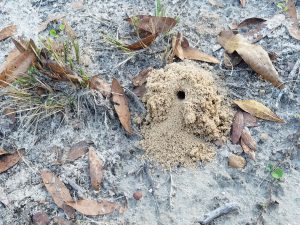
The entrance to a miner bee burrow.
Homeowners may occasionally note small mounds of soil in sandy areas of their lawns. Sometimes sporting a small hole in the center, these are the nesting sites of solitary, ground-nesting bees or hornets. Miner bees or digger bees build underground chambers, usually in well-drained, otherwise bare areas of sandy soil. Multiple bees may choose to dig their nests in the same location, though each bee makes its own tunnel and they do not live communally. Each bee lays her eggs in the nest she has excavated. She gathers pollen to feed the young when they hatch, stocks the larder, and leaves. When the young emerge from the nest, they fly away and do not remain; they will dig their own nests when they are ready to reproduce. While there is no need to control these insects (they serve as fantastic pollinators), the mounds of soil they make may be aesthetically displeasing to some people. Keeping a healthy lawn with no bare patches can deter miner bees from nesting in an area. Irrigation sprinklers can also help to keep the ground moist; these bees prefer dry soil, so it may keep them away. Care must be taken not to over-water a lawn, however!
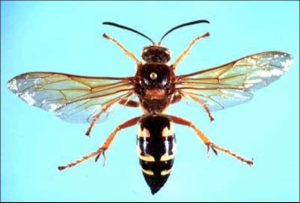
A cicada killer wasp. Photo credit: Division of Plant Industry
Another species of note is the cicada killer hornet. Also known as the giant ground hornet, these insects grow to a size of about an inch and a half in length. Instead of pollen, they capture cicadas to feed their young. Like the miner bee, though, they are not harmful. Females do possess a stinger which they use to hunt their prey. Males may try to warn people or animals away from their burrows by acting aggressive, but they have no stingers. Some may see the large size of the cicada killer and wonder if the so-called “murder hornet” has made its way from Washington state to Florida, but as of this writing it has not. Unless you are a cicada, you have nothing to fear.
One ground-dwelling hornet that does warrant some concern is the yellowjacket. These are communal hornets, living in hives that are often build underground. Yellowjackets are known for their bad attitudes, attacking anyone who disturbs the entrance to their nest. They can be beneficial, being predators of many other insects including plant pests. A colony located too close to human dwellings or areas of activity is most often a nuisance, however. Any attempts to control yellowjacket nests should be done at night when they are less active. Protective clothing is recommended even then. Large or difficult to reach nests may require the attention of a certified pest control company.
For more information on these topics, see our EDIS publications:
Miner Bees: https://edis.ifas.ufl.edu/publication/in912
Cicada Killers: https://edis.ifas.ufl.edu/publication/in573
Yellowjackets: https://edis.ifas.ufl.edu/publication/IN238
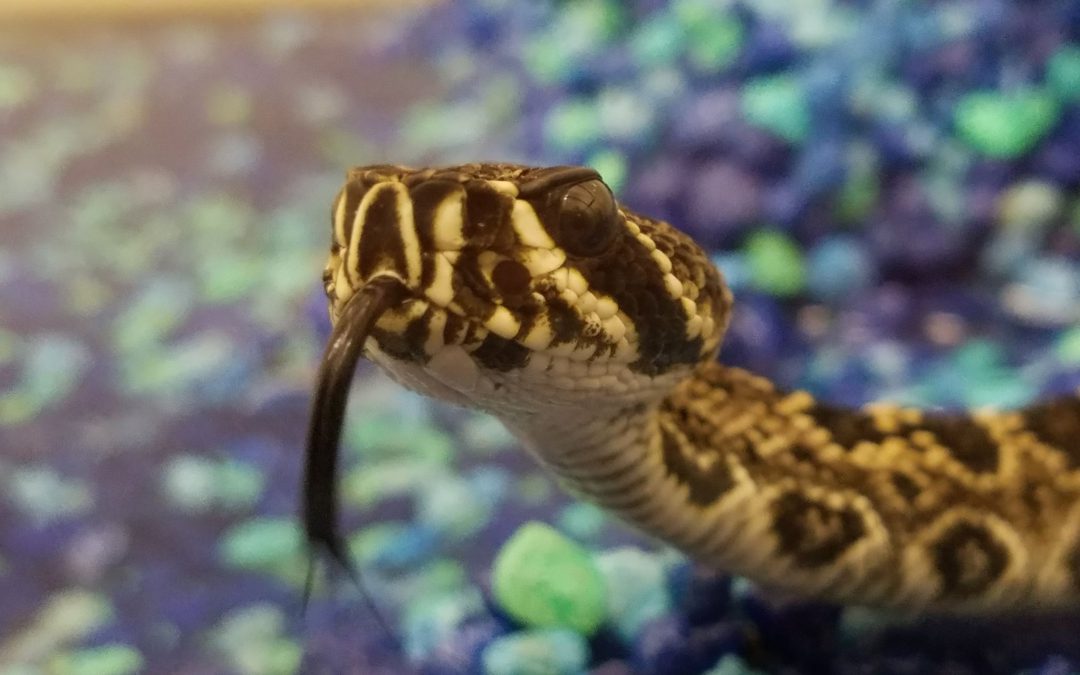
by Evan Anderson | Sep 16, 2021
Here in Florida, we have snakes. Some may say we have lots of snakes. While their presence may be something to be expected out in wild areas, homeowners often find it alarming when these creatures show up near places where we live. The reaction is often a simple one: if it is a snake, kill it.
Dealing with snakes should not be like this, however. Although some are venomous, many others are harmless to humans and make valuable contributions to the local ecology. As more natural areas become developed, wildlife such as snakes are increasingly pushed into close contact with people, so learning to live with them is important.
Of the 46 species of snakes found in Florida, only 6 are venomous. The chances of being bitten by one of these venomous snakes is very low; there are only 7,000-8,000 bites in the entire U.S. each year. Fatalities are even more rare, with less than ten people typically dying across the country annually from venomous snakebites. In a country with a population of around 330 million, that’s not a lot.
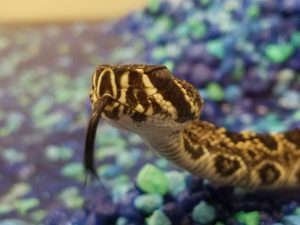
A venomous Eastern diamond-backed rattlesnake.
Snakes, especially venomous ones, should be treated with respect, however. Knowing how to identify a snake can be an important step in knowing how to react to them, and understanding their behavior can help avoid unfortunate encounters. The venomous snakes we have in Florida are the copperhead, the coral snake, the cottonmouth or water moccasin, the Eastern diamond-backed rattlesnake, the pygmy rattlesnake, and the timber rattlesnake. For help in identifying these species, see our guide on EDIS at https://edis.ifas.ufl.edu/publication/UW229.
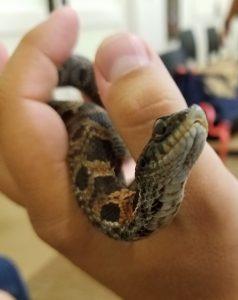
A harmless hognose rattlesnake.
Understanding snake behavior, including their feeding habits and preferred habitats, is also important. If you can make the areas you live in less hospitable to snakes, especially venomous ones, they’ll be less likely to move in. This doesn’t mean getting rid of every snake out there – some snakes that are harmless to humans may be predators that consume other snakes (including venomous ones) or rodents. Because venomous snakes often consume rodents and other small animals, allowing the nonvenomous ones to control populations of prey can help keep dangerous snakes out!
Watch out for areas where snakes may shelter, including tall grass, overgrown shrubs, piles of brush and wood, or debris. There is no need to remove all such things from a property, as other wildlife use them as well, but keep them away from houses and areas where people frequent. Also be sure to keep rodents under control in and around buildings to avoid attracting snakes that feed on them. You can find more information on managing habitat to deal with snakes at https://edis.ifas.ufl.edu/publication/UW260.

by Evan Anderson | Jul 22, 2021

A good garden takes some time and effort!
Gardening in North Florida can be a challenge. Conditions in the panhandle are very different than in most other locations in the country, and learning what and how to grow takes time! Here are a few tips to help the aspiring gardener adapt to the unique climate and soils here.
- Know Your Varieties
Not every variety of vegetable is the same. Some differences may be obvious – a purple cabbage isn’t hard to distinguish from a green one, and a cherry tomato will never be mistaken for a beefsteak. Other differences are not so obvious, and you may have to do some research to figure out what you’re getting with a particular cultivar. Some are better adapted to growing in the heat, or may have resistances to certain diseases or pests. See the Florida Vegetable Gardener’s Guide (https://edis.ifas.ufl.edu/publication/VH021) or the Vegetable Production Handbook of Florida (https://edis.ifas.ufl.edu/publication/CV292) for varieties that do well in Florida.
- Light is Your (Plants’) Friend
Space for a garden is often limited, but remember that light can’t be! A shady location leads to unhappy vegetables. Plants produce energy by absorbing the rays of the sun, and garden plants need a lot of light to make the food we eat. If your plants are looking spindly and not producing well, look up and see what’s shading them. If possible choose a location for your garden that gets at least six hours of full sun each day. Even more is better!
- Plant at Proper Times
There are really two growing seasons in North Florida: spring and fall. It gets too cold for most plants in the winter, and tropical plants will especially suffer. The heat of the summer is similarly hard on a garden. Few plants can continue producing their best in the face of such high heat and humidity. Okra and peppers might soldier on through the heat, but cool-weather loving crops like peas, lettuce, and broccoli will meet defeat. Know what temperatures each plant prefers and plan your garden accordingly. Consider starting transplants indoors early to get the most growing time possible – February or March is a good time to start transplants in the spring, and September in the fall.
- Watch your Watering
Even watering is important for crops, and the weather rarely cooperates. The occasional drought followed by a ten inch rain can make managing irrigation a headache, but try to keep up with the weather! Remember that warmer weather causes more evaporation, and larger plants take up more water. That being said, a ten-inch rain during the summer will probably supply all the water your plants need for the day, so consider turning off the irrigation when it rains. It’s just as possible to overwater as it is to let plants dry out too much.
- Be Wise When you Fertilize

A raised bed is a good choice for gardening where soil is particularly sandy.
The soil in much of our area is very sandy. In some places, it’s nothing but! Highly sandy soils don’t hold on to much in the way of water or nutrients, so the gardener needs to balance their inputs to adjust for this fact. Get your soil tested so you know what nutrients are in the soil (your local Extension office can help with that). When you do fertilize, don’t dump all your plants need for the year on at once! Chances are, much of it will just wash away in the next rain. Instead, split your fertilization up into several applications over the growing season. Try also using slow-release fertilizers or organic sources of nutrients that break down over time and feed plants. You can also amend your soil with organic matter (things like compost and manure are good sources) to help add some nutrient-holding capacity. Organic matter can also help deter sandy-soil-loving nematodes, which are microscopic worms that can damage the roots of plants.
- Scout for Pests and Diseases
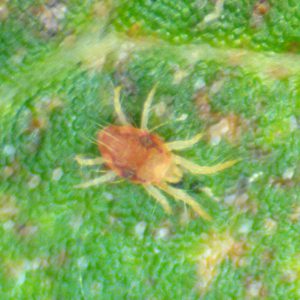
Spider mites are a tiny, but common garden pest.
Florida’s climate makes it very attractive not just for retirees, but also for all sorts of plant pests and diseases as well. Keep a close eye on your garden and deal with anything out-of-the-ordinary before a problem becomes overwhelming. Pests of all sorts, whether they are weeds, insects, or fungi, are much easier to eliminate when they’re young or in small numbers. Remember that not everything is a plant pest – some insects are beneficial predators that can keep the enemies at bay, so don’t always immediately reach for a chemical that’s going to kill everything. Natural and biorational options such as neem oil, Bacillus thuringiensis or Bt, insecticidal soap, or diatomaceous earth can work just as well as other pesticides, and can help avoid harm to pollinators and beneficials. Know the pest you’re treating before you try getting rid of it! See our EDIS publication on natural garden products (https://edis.ifas.ufl.edu/publication/IN197) for more information.
Remember not to get discouraged! If you need help figuring out what’s going wrong in your garden, you can always talk to the folks at your local Extension office. There’s also plenty of other information out there – look for our other EDIS publications on a variety of topics (https://edis.ifas.ufl.edu/). Happy gardening!
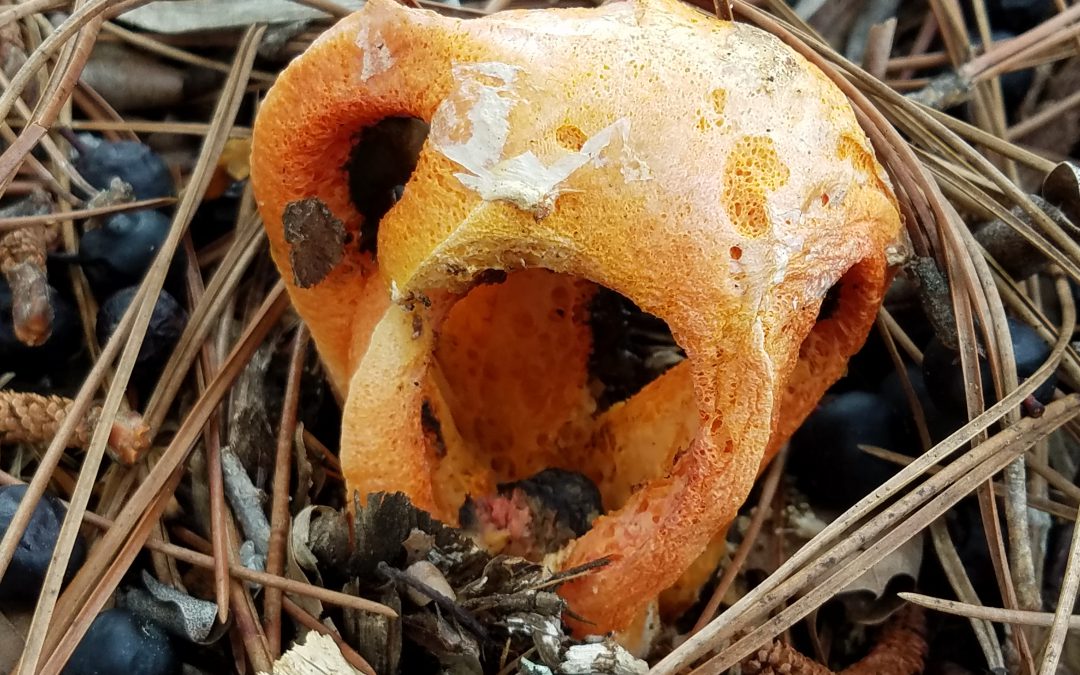
by Evan Anderson | Jul 1, 2021
While there are many fungi that produce mushrooms out in the world around us, there are some that are particularly notable. Edible varieties such as the lion’s mane, jelly ear, and chanterelle may be welcome additions to the landscape. We may have to look out for harmful fungi that cause leaf spots on our landscape plants, toxic mushrooms that could cause harm if ingested, or even things like sooty mold that indicate the presence of another problem (plant-damaging insects, in that case). Then, there are stinkhorn mushrooms.
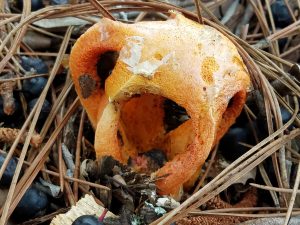
Stinkhorn Mushroom. Photo courtesy of Evan Anderson.
While not poisonous (indeed, some varieties are edible) and not harmful to plants, these mushrooms are usually unwanted by homeowners. Why? There are two things that make them undesirable. First, they emit an odor that may resemble rotting meat, raw sewage, or some delightful combination of the two. Secondly, some species strongly resemble…well, the genus name Phallus may give some indication. Suffice to say that if your landscape mulch appears to have an inappropriate anatomical addition after a cool rain, you may have a stinkhorn mushroom.
These fungi are decomposers of dead plant material, breaking down wood chips, fallen leaves, or old tree stumps. This is an incredibly important role in the ecosystem, but stinkhorns are particularly offensive as they go about doing their job. The reason for their smell, specifically, is because they need to spread their spores. To do so, they attract insects. Unlike many plants which use beautiful flowers with pleasant fragrances to attract pollinators, stinkhorns attract a different crowd of helpers. They exude a slimy mass of spores that are appealing to flies and other invertebrates that enjoy feces, dead animals, and the like. The insects transport spores from place to place as they feed on the slime.
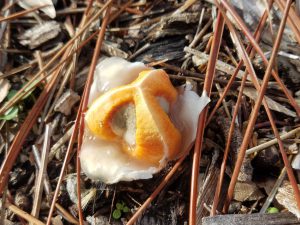
Stinkhorn Mushroom. Photo courtesy of Evan Anderson.
If you smell or see these mushrooms in your yard or landscape, don’t worry. They won’t last long and may be beneficial to the environment. If they become intolerable, stirring mulch up can help discourage their growth, or they can be removed physically (perhaps with a tool or while wearing gloves, at least). If they recur in an area time after time, look out for their early stages of growth, which may resemble puffballs or small eggs, and remove them then. Fungicides tend not to be effective and may harm other beneficial fungi in the environment.
For more information, see our EDIS publication on stinkhorn mushrooms at https://edis.ifas.ufl.edu/publication/PP345.

















